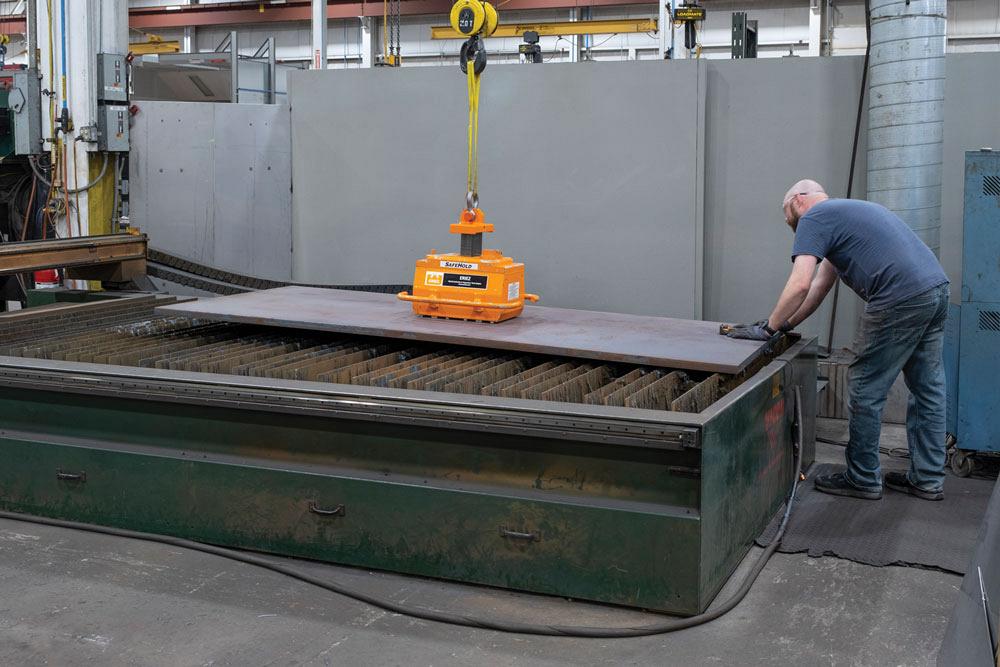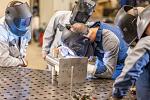metalworking market manager
- FMA
- The Fabricator
- FABTECH
- Canadian Metalworking
Moving heavy plate
A look at how lifting magnets can solve material handling challenges
- By Andy Kloecker
- September 19, 2022
- Article
- Fabricating

With lifting magnets, all lifting is done from above the plate with no need to place anything underneath.
Fabricators have several material handling options to choose from when working with heavy plate, including lifting magnets. These powerful devices can make material handling and loading/unloading of shop equipment easy and safe.
Lifting magnets eliminate some of the challenges associated with other lifting devices. Plate clamps, chain slings, and other material handling devices require the lifting mechanism to be underneath the plate, whereas lifting magnets pull from the top and do not require access from underneath.
Other options may require an operator to pry a corner up or shimmy the plate off the skid, introducing the potential for an employee to hurt themselves. With lifting magnets, all lifting is done from above the plate with no need to place anything underneath. If a heavy plate is sitting on the floor or on a skid, the magnet is simply placed on top, activated, and the plate is ready to be moved. The crane or hoist holding the magnet is doing all the work. Not having to lift an item keeps the operator out of harm’s way.
Another advantage is the ease of repositioning the lift magnet in the event of an uneven or out-of-level lift. The operator simply sets down the material, deactivates the magnet and repositions, then reactivates and completes the lift. With other methods, the operator will have to maneuver straps or chains underneath the load. Lift magnets are very convenient and a huge time saver.
Choosing the Right Lift Magnet
Choosing the correct magnet capacity and arrangement of multiples is important and is determined by the size, weight, and characteristics of the load.
There are two basic categories of magnet: permanent and electromagnets. Both magnet types are used to lift and move heavy plate.
Permanent magnets are typically lever-operated and do not require electricity or battery power. Flipping the lever to "on" orients the internal ceramic or rare-earth magnet blocks to induce magnetism into the plate for lifting. As the lever moves to the "off" position, the internal magnetic poles realign to pull the magnetism from the plate for easy release. The internal permanent magnet material retains its strength indefinitely unless heated to extreme temperatures or subjected to intense electrical fields. Because permanent magnets have limited load capacities, multiple magnets on a spreader beam can handle larger or heavier loads.
Electromagnets require constant DC voltage for operation. These magnets tend to be more convenient for the operator since they involve simple push-button operation. However, electromagnetic systems typically are more expensive due to the electrical control components and wiring involved. Coil and housing variations allow for electromagnet designs specific to the load parameters, along with much higher capacities than permanent magnets.
If a shop wants to lift larger but thinner plate or sheet, it might require multiple magnets on a spreader beam. Thicker plate with smaller dimensions or blocks of steel don’t deflect as much, or at all. For these applications, a single magnet may be appropriate provided it is rated higher than the load weight.
A lift magnet professional should survey each unique application before any lifting magnet is purchased. They will assess the different loads to be lifted, specify the proper magnet, and determine the proper arrangement of multiple magnets, if required.

It is of the utmost importance to ensure the magnet or magnet system has been specified for a particular application’s size, shape, and weight range.
Additional Considerations
Depending on the application, operator convenience may be an important factor to consider. Fabricators working with high-volume, high-cycle applications might find that push-button controls are easier and more efficient than flipping levers on and off.
Material temperature often is a factor in fabrication shops. Steel parts are often preheated for welding applications or have just been cut on a plasma table. If permanent magnets are exposed to high temperatures, long-term field strength loss can occur. Most rare-earth-based lift magnets have an internal temp limit of 176 degrees F, while ceramic-based magnets can handle much higher temperatures without permanent strength loss.
Beyond application conditions, another area to consider is crane capacity. Shop owners, managers, and operators must ensure the crane has enough capacity to hold the weight of the magnet and all accessories plus the heaviest load to be lifted. Ideally, the crane or hoist should be capable of lifting all devices suspended from the hook plus the maximum capacity of those devices.
Another consideration with electromagnet systems is the potential for power outages. If the power is lost, the magnet loses its lifting power and the load can drop. Battery backup systems are available to take over in the event of a power outage, preventing loaddrop safety issues.
Lift Magnet Misconceptions
It is important to note that there are variables other than weight to consider when choosing a magnet. Thick plate often is easier to handle than thinner plate or sheet. Thin sheets are more flexible, will deflect more, and have less steel to absorb a magnet’s full field strength. Lighter, thinner sheets often require multiple magnets equally spaced on a spreader beam. This arrangement keeps the sheet flat and level and distributes the holding force evenly over the entire sheet.
For example, a fabricator with a 2,000-lb.-capacity magnet can easily handle a 36- by 36- by 4-in. plate weighing 1,833 lbs. However, that same magnet would not be appropriate for a 48- by 96- by 1/8-in. sheet weighing only 163 lbs. There is too much flexibility in that thin sheet and it doesn’t absorb enough magnetism for a secure and level lift. It is imperative the entire range of sizes to be lifted is discussed with the magnet professional, from thin and light up to thick and heavy.
Another misconception is lifting magnets are only used for flat items like plate and sheet. They also can be used for round items like tube and pipe. It is important to make sure the magnet is designed to handle the load to be lifted. The magnet’s contact surface is designed to handle flat materials only, or both flat and round items. Some models can be equipped with special pole shoes that contour better to a certain part diameter or shape.
Operators also need to know the type of material being handled. A lift magnet requires the material to have magnetic properties like a mild or low-carbon steel, cast and ductile iron, or 400 series stainless steel. Fabricators looking to move 300-series stainless steel, for example, will need to look for another material handling option. Contacting a magnet manufacturer with material questions is a good starting point.
Lift Magnet Best Practices
It is of the utmost importance to make sure the correct magnet or magnet system has been specified for a particular application’s size, shape, and weight range. An application survey by a lift magnet professional is highly recommended as a first step. Do not guess whether the magnet will work for the load. Instead, check the load capacity charts or with the manufacturer to make sure it is rated properly for the specific load.
Cleanliness of the plate is important no matter where it’s coming from. Dust, chips, and debris can be problematic and limit surface contact with the magnet. Fabricators should ensure the steel is clean, smooth, flat, and free of paint and corrosion.
Making sure the magnet’s contact surface is clean and smooth is critical to optimal lifting performance as well. Polishing the face of the magnet with a Scotch-Brite pad or a dual-action sander will help remove any scratches or burrs that prevent good contact with the steel.
Magnet placement on the load also is important. Positioning the magnet over the load’s centre of gravity will ensure a level, safe, and successful lift.
Shop floor personnel also should stand clear of the load if feasible to reduce injury risks. In addition, nobody should ever be underneath a lifted part. Operators should ensure the material is moved in such a way that it does not contact any solid objects like a building column, forklift, or a piece of equipment, which could potentially knock the plate off of the magnet.
Lift Magnet Training and Use
Like most shop equipment, training is extremely important to ensure proper magnet use. Many magnet manufacturers will offer training, literature, presentations, and hands-on help to make sure fabricators are properly equipped to move materials safely.
Lift magnets are governed by ASME B30.20-2021 Below-the-Hook Lifting Devices. This document also provides guidelines for plate clamps, chain slings, spreader beams, and anything that hangs from a crane hook to lift materials.
The guidelines state operators should be trained on the proper use and care of lift magnets. There are also guidelines on how frequently the lift magnets should be inspected based on the frequency of use. For example, high-cycle applications should be inspected more frequently than low-cycle applications. Any manufacturing facility and safety department should have a copy of the guidelines on hand for employee reference.
Andy Kloecker is the metalworking market manager for Eriez, 2200 Asbury Rd., Erie, Pa. 16506, 814-835-6000, www.eriez.com.
About the Author
subscribe now


Keep up to date with the latest news, events, and technology for all things metal from our pair of monthly magazines written specifically for Canadian manufacturers!
Start Your Free Subscription- Trending Articles
Class is in session for college connections

BlueForge Alliance partners with Nuts, Bolts & Thingamajigs to develop Submarine Manufacturing Camps

Engine-driven welding machines include integrated air compressors

Orbital tube welding webinar to be held April 23

Portable system becomes hot tech in heat treatment

- Industry Events
ZEISS Quality Innovation Days 2024
- April 15 - 19, 2024
Tube 2024
- April 15 - 19, 2024
- Düsseldorf, Germany
CTMA Economic Uncertainty: Helping You Navigate Windsor Seminar
- April 30, 2024
- Windsor, ON Canada
MME Winnipeg
- April 30, 2024
- Winnipeg, ON Canada
CTMA Economic Uncertainty: Helping You Navigate Kitchener Seminar
- May 2, 2024
- Kitchener, ON Canada















